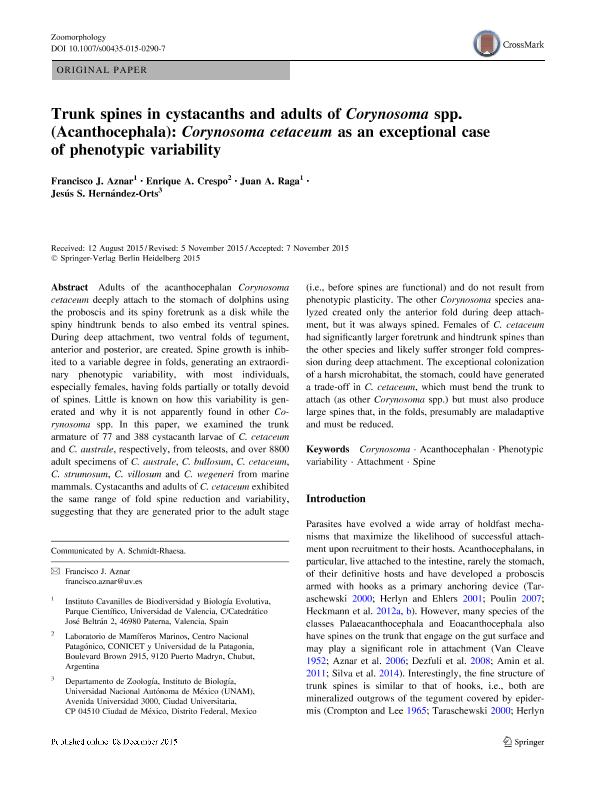Artículo
Trunk spines in cystacanths and adults of Corynosoma spp. (Acanthocephala): Corynosoma cetaceum as an exceptional case of phenotypic variability
Aznar Avendaño, Francisco Javier; Crespo, Enrique Alberto ; Raga, Juan A.; Hernández Orts, Jesús Servando
; Raga, Juan A.; Hernández Orts, Jesús Servando
 ; Raga, Juan A.; Hernández Orts, Jesús Servando
; Raga, Juan A.; Hernández Orts, Jesús Servando
Fecha de publicación:
11/2015
Editorial:
Springer
Revista:
Zoomorphology (Berlin Print)
ISSN:
0720-213X
e-ISSN:
1432-234X
Idioma:
Inglés
Tipo de recurso:
Artículo publicado
Clasificación temática:
Resumen
Adults of the acanthocephalan Corynosoma cetaceum deeply attach to the stomach of dolphins using the proboscis and its spiny foretrunk as a disk while the spiny hindtrunk bends to also embed its ventral spines. During deep attachment, two ventral folds of tegument, anterior and posterior, are created. Spine growth is inhibited to a variable degree in folds, generating an extraordinary phenotypic variability, with most individuals, especially females, having folds partially or totally devoid of spines. Little is known on how this variability is generated and why it is not apparently found in other Corynosoma spp. In this paper, we examined the trunk armature of 77 and 388 cystacanth larvae of C. cetaceum and C. australe, respectively, from teleosts, and over 8800 adult specimens of C. australe, C. bullosum, C. cetaceum, C. strumosum, C. villosum and C. wegeneri from marine mammals. Cystacanths and adults of C. cetaceum exhibited the same range of fold spine reduction and variability, suggesting that they are generated prior to the adult stage (i.e., before spines are functional) and do not result from phenotypic plasticity. The other Corynosoma species analyzed created only the anterior fold during deep attachment, but it was always spined. Females of C. cetaceum had significantly larger foretrunk and hindtrunk spines than the other species and likely suffer stronger fold compression during deep attachment. The exceptional colonization of a harsh microhabitat, the stomach, could have generated a trade-off in C. cetaceum, which must bend the trunk to attach (as other Corynosoma spp.) but must also produce large spines that, in the folds, presumably are maladaptive and must be reduced.
Palabras clave:
CORYNOSOMA
,
ACANTHOCEPHALAN
,
PHENOTYPIC VARIABILITY
,
ATTACHMENT
,
SPINE
Archivos asociados
Licencia
Identificadores
Colecciones
Articulos(CCT-CENPAT)
Articulos de CTRO.CIENTIFICO TECNOL.CONICET - CENPAT
Articulos de CTRO.CIENTIFICO TECNOL.CONICET - CENPAT
Citación
Aznar Avendaño, Francisco Javier; Crespo, Enrique Alberto; Raga, Juan A.; Hernández Orts, Jesús Servando; Trunk spines in cystacanths and adults of Corynosoma spp. (Acanthocephala): Corynosoma cetaceum as an exceptional case of phenotypic variability; Springer; Zoomorphology (Berlin Print); 135; 11-2015; 19-31
Compartir
Altmétricas



